| Article ID | Journal | Published Year | Pages | File Type |
|---|---|---|---|---|
| 6328395 | Science of The Total Environment | 2015 | 6 Pages |
Abstract
Saltwater intrusion (SWI) can result in the loss of dominant vegetation from freshwater habitats. In northern Australia, sea level is predicted to rise 17-50Â cm by 2030-2070. This will exacerbate the impact of SWI, threatening Ramsar-listed habitats. Soil bacteria in these habitats play a significant role in biogeochemical cycling, regulating availability of essential nutrients such as nitrogen to vegetation. However, there is limited understanding as to how SWI will impact these soil bacteria. Floodplain soil samples were collected from the South Alligator River floodplain in Northern Australia from sites with contrasting histories of SWI. A SWI event was simulated over 7Â days with treatments of saltwater and freshwater. Bacterial community composition before and after treatment were measured using next generation sequencing of bacterial DNA. Sites with no history of SWI showed no significant changes in community taxonomic composition following treatments, suggesting the community at these sites have broad functional capacity which may be due to their historic conditioning over many years. Sites with a history of SWI showed a significant response to both treatments. Following saltwater treatment, there was an increase in sulfate-reducing bacteria, which are known to have an impact on carbon and nitrogen cycling. We suggest that the impact of SWI causes a shift in the soil bacteria which alters the community to one which is more specialised, with implications for the cycling of essential elements and nutrients.
Keywords
Related Topics
Life Sciences
Environmental Science
Environmental Chemistry
Authors
Tiffanie M. Nelson, Claire Streten, Karen S. Gibb, Anthony A. Chariton,
